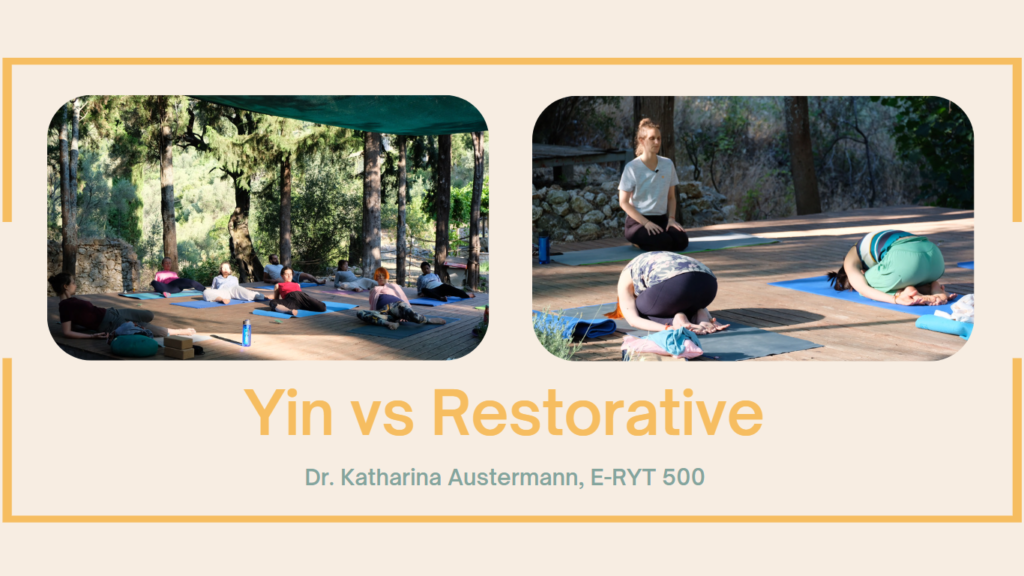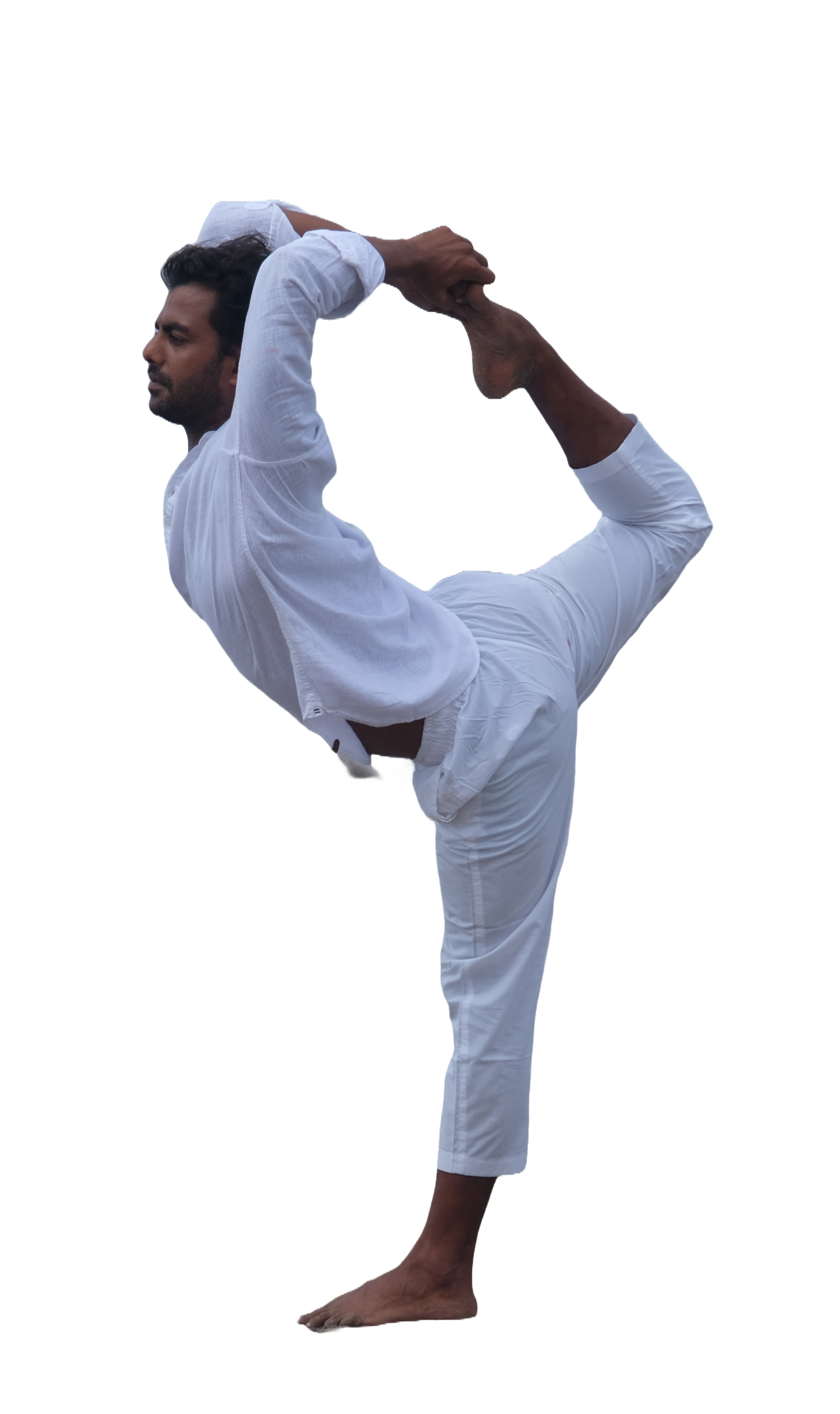Yin Yoga and Restorative Yoga are two popular Yoga styles that both stimulate the parasympathetic nervous system – our rest and digest response – and promote deep relaxation. Even though they have similarities, they are not the same!
Let’s Dive In: Exploring Yin Yoga vs. Restorative Yoga Side by Side
Understanding Yin Yoga
Yin Yoga, as we know and practice it today, can be attributed to the pioneering work of Paul Grilley, who developed this style in the late 1980s. Drawing inspiration from Daoist Yoga, Grilley skillfully integrated the ancient Indian yoga traditions with the profound wisdom of the Chinese energy system known as meridians. With a deep understanding of anatomy and the meridian theory, Grilley created a unique approach to Yin Yoga that harmoniously blends these diverse influences.
Apart from the principles of Chinese Taoist philosophy Yin yoga is influenced by the concept of yin and yang. Yin represents stillness, surrender, and cooling energy, while yang represents activity, strength, and heating energy. In Yin Yoga, the aim is to balance the yang aspects of our lives by embracing the yin qualities of receptivity, introspection, and surrender.

Discover the Power of Stillness: Essential Yin Yoga Postures for Deep Stretching and Relaxation
Yin Yoga is a slow-paced and introspective style of yoga that focuses on long-held passive poses to target the deep connective tissues of the body, such as ligaments, tendons, and fascia.
In Yin Yoga, the postures are typically seated or reclined, and they are held for an extended period, usually ranging from one to five minutes or more. The extended holds allow for a gentle and sustained stretch, targeting the deeper layers of the body. Props such as bolsters, blankets, and blocks are used to support the body. They enable practitioners to find the appropriate level of support, ensure a safe and effective yin yoga practice and allow for a release of tension in the target areas.
In Yin Yoga, alongside the practice of holding postures for extended periods, a fundamental principle to keep in mind is the 80% rule. This rule serves as a guiding principle throughout the practice, emphasizing the importance of not pushing beyond 80% of our capacity in each pose. By respecting this threshold, we can effectively target and stretch the deeper yin tissues without placing excessive strain on them or transferring undue pressure to the yang muscles. It is crucial to avoid going too deep into the pose, as it may lead to injuries.
How Yin Yoga Encourages Practitioners to Embrace Stillness and Inner Growth
Yin Yoga encourages practitioners to find their edge in each pose—the point where they feel a gentle and tolerable sensation—and to then surrender and relax into that edge. The practice invites a sense of patience, acceptance, and non-striving, as opposed to actively seeking flexibility or muscular engagement.
In the practice of Yin Yoga, it is essential to embrace a mindful approach towards discomfort. While we aim to avoid unnecessary strain, it is important to acknowledge that a certain level of discomfort, often referred to as the “orange” zone, is desired. By venturing beyond our familiar “green” comfort zone, we can effectively engage and stimulate our deeper tissues. This intentional stress activates transformative changes at a profound level and aids in enhancing or preserving flexibility around the joints. Rather than merely seeking comfort, Yin Yoga encourages us to embrace the beneficial challenge that arises from exploring the edges of our physical sensations.
The slower pace and longer holds in Yin Yoga provide an opportunity for deep relaxation and introspection. As the body begins to release tension, the mind can also find stillness. The practice often incorporates mindfulness techniques, breath awareness, and meditation, allowing practitioners to cultivate a greater sense of present-moment awareness and inner calm.
Discover the Benefits of Yin Yoga: Sense of Balance and Flexibility
Yin Yoga offers several benefits. It helps to increase flexibility and joint mobility, especially in areas such as the hips, pelvis, and lower spine. The practice stimulates the flow of energy (qi) in the body, promoting balance and vitality. It also provides an opportunity for emotional release and introspection, helping to calm the mind and reduce stress and anxiety.
Yin Yoga is suitable for practitioners of all levels, including beginners. It complements more active and dynamic styles of yoga or physical activities by offering a counterbalance of stillness and passive stretching.
Understanding Restorative Yoga
Restorative Yoga draws its foundation from the teachings of the renowned yoga master B.K.S. Iyengar. In the 1970s, Judith Lasater, a dedicated student of Iyengar, developed Restorative Yoga in the United States. This gentle practice was specifically designed to support individuals in their recovery from illness or injury. The primary emphasis of Restorative Yoga lies in creating a nurturing environment that promotes deep relaxation and healing. It is a gentle and deeply relaxing style of yoga that focuses on rest and rejuvenation. It is designed to promote deep relaxation, release tension, and restore the body and mind. Unlike more active yoga styles, Restorative Yoga involves passive poses supported by props, allowing for complete ease and comfort.
In Restorative Yoga, the poses are held for an extended period, often ranging from 5 to 20 minutes or more. The body is fully supported by bolsters, blankets, blocks, and other props to create a nurturing and comfortable environment. The supported positions aim to minimize muscular effort and promote a state of deep relaxation and surrender.

Restorative Yoga: Nurturing Deep Relaxation and Healing as the Primary Goal
The primary goal of Restorative Yoga is to activate the body’s relaxation response, also known as the parasympathetic nervous system. By intentionally slowing down and supporting the body in restful postures, Restorative Yoga encourages the release of tension and stress held within the body and mind.
Beyond its healing benefits, Restorative Yoga serves as a powerful antidote to chronic stress, offering a sanctuary for complete relaxation. In contrast to the “no-pain-no-gain” mindset often associated with physical practices, Restorative Yoga embraces a different philosophy. It encourages the release of tension, surrendering to the present moment, and cultivating self-compassion. Rather than forcing the body into demanding postures, Restorative Yoga invites practitioners to let go, allowing for deep rest and rejuvenation. It is a practice that honors the importance of nurturing ourselves and finding solace in the gentle and compassionate approach it embodies.
As well as Yin Yoga Restorative Yoga often incorporates breath awareness, guided meditation, and mindfulness practices to enhance the relaxation experience.
Restorative Yoga: Rejuvenate and Restore with Countless Benefits for Mind, Body, and Soul
The practice of Restorative Yoga offers numerous benefits. It can help reduce stress, anxiety, and fatigue, while promoting overall well-being and a sense of balance. The gentle stretches and supported poses aid in releasing muscular tension and increasing flexibility. Restorative Yoga can also improve sleep quality and provide relief for individuals experiencing chronic pain or recovering from injuries.
Restorative Yoga is suitable for practitioners of all levels, including those with limited mobility or physical limitations. It is completely about restoration and thus a great Yoga practice for people recovering from injuries or illnesses.
Exploring the Contrasts: Yin Yoga vs. Restorative Yoga
1. Intensity and Duration
Yin Yoga poses require a moderate level of intensity, as they target the deep connective tissues. Restorative Yoga, on the other hand, emphasizes complete relaxation and therefore involves very gentle poses.
2. Active vs. Passive
Even though Yin Yoga is a passive Yoga practice it requires some effort to maintain the pose, while Restorative Yoga focuses on completely surrendering into the support of props, allowing the body to rest deeply.
3. Stressing vs. Release
In Yin Yoga, the emphasis is on gentle stress of the connective tissues, while Restorative Yoga focuses more on releasing tension and finding comfort in each pose.
4. Energetic Impact
Yin Yoga aims to stimulate the flow of energy through the body’s meridians, whereas Restorative Yoga primarily focuses on activating the relaxation response.
The Similarities
1. Mindfulness and Presence
Both Yin Yoga and Restorative Yoga invite practitioners to cultivate mindfulness, awareness, and a deep connection with the present moment.
2. Stress Relief and Relaxation
Both practices offer profound relaxation benefits, helping to reduce stress, calm the nervous system, and promote overall well-being.
3. Supportive Props
Both Yin Yoga and Restorative Yoga often utilize props to provide support and create a comfortable environment for deep relaxation and tension release.
4. Breath Awareness
Both practices encourage conscious breathing techniques to enhance relaxation and focus.
Choosing between Yin Yoga and Restorative Yoga and Finding the Right Practice for Your Needs
When deciding between Yin Yoga and Restorative Yoga, consider your intentions and physical needs. If you seek a practice that focuses on stretching and stimulating the energy flow, Yin Yoga might be the right fit for you. On the other hand, if you require deep relaxation and restoration, Restorative Yoga offers a nurturing and supportive practice. Ultimately, it’s essential to listen to your body and choose a practice that resonates with your needs and preferences.
Do you want to learn more about the effects of Yin Yoga on your body and mind?
The come and join us for our Yin Yoga teacher training in Bali or our Yin Yoga teacher training Germany.
Our training program encompasses a comprehensive curriculum that covers the essential aspects of Yin Yoga, including anatomy, meridian theory, sequencing, prop usage, and meditation. You’ll receive well-rounded instruction from experienced teachers, enabling you to develop a strong foundation for your Yin yoga practice.
If you’re a yoga instructor, our Yin Yoga teacher training will equip you with valuable tools to diversify your offerings and cater to a wider range of students. You’ll learn how to guide others through the subtle nuances of Yin Yoga, fostering relaxation, mindfulness, and deep tissue release.
Let’s meet on the Yin side of Life!


